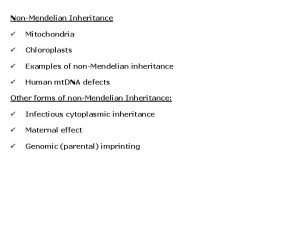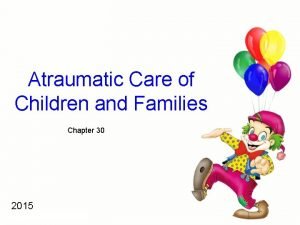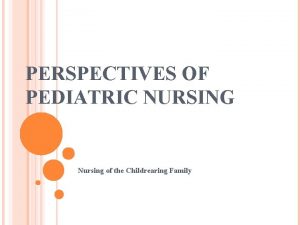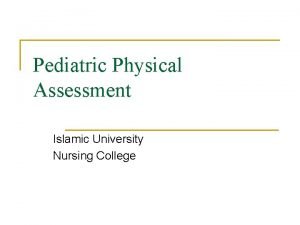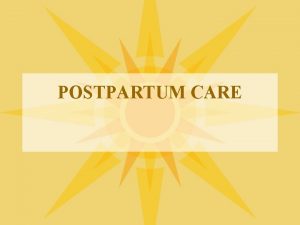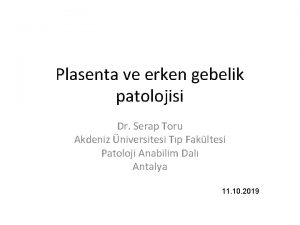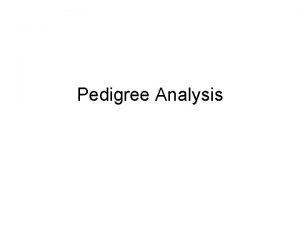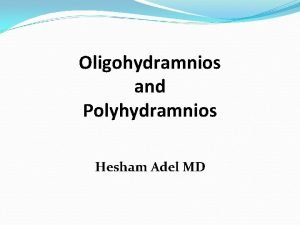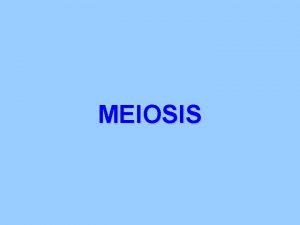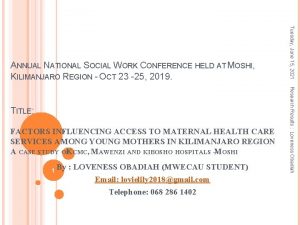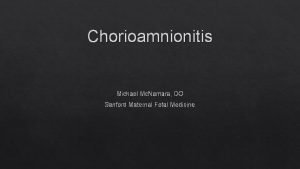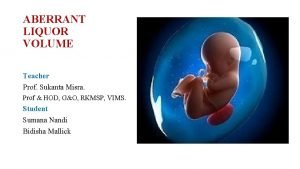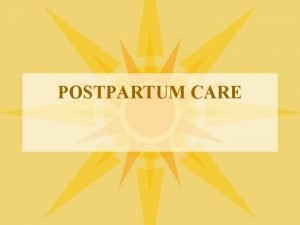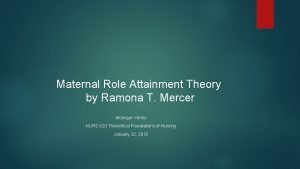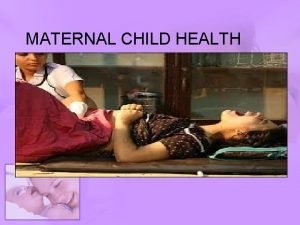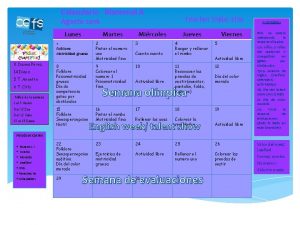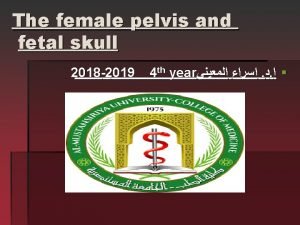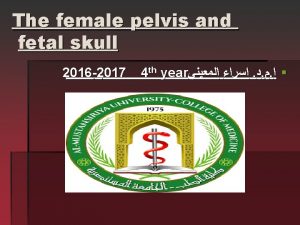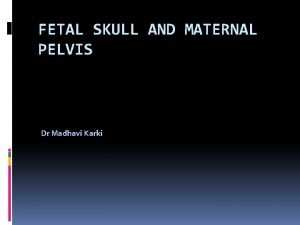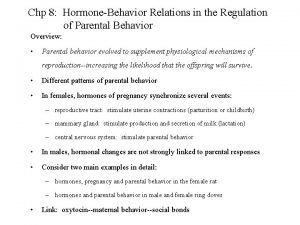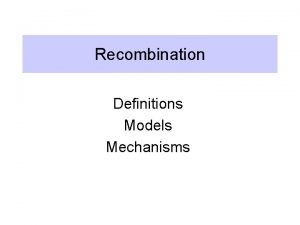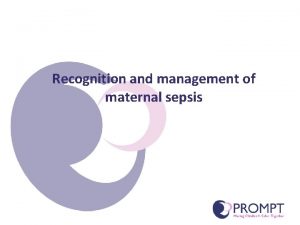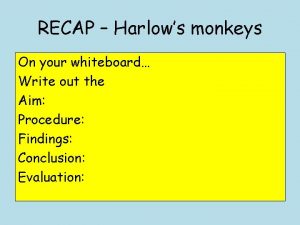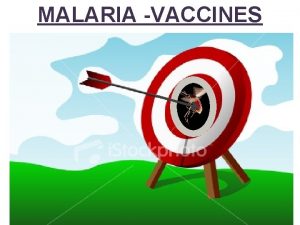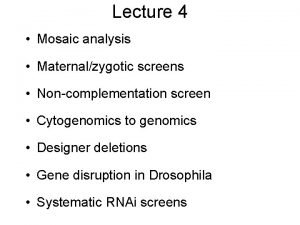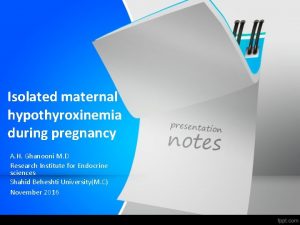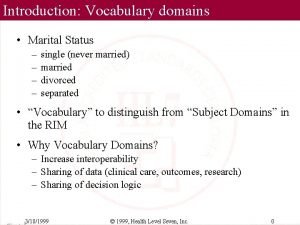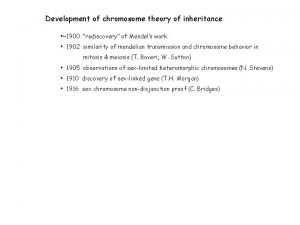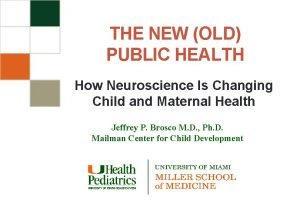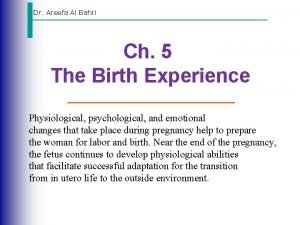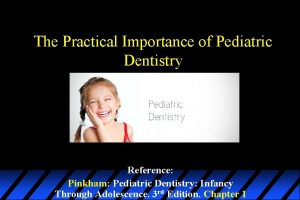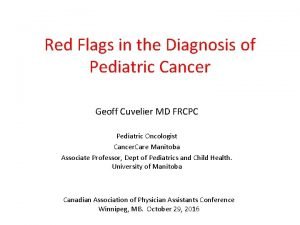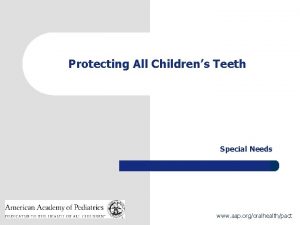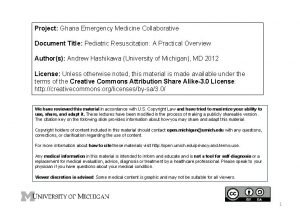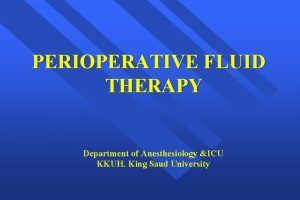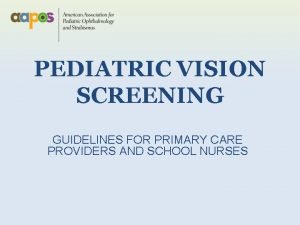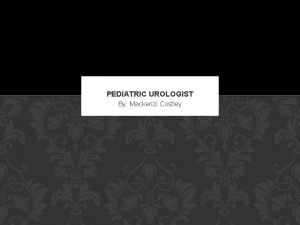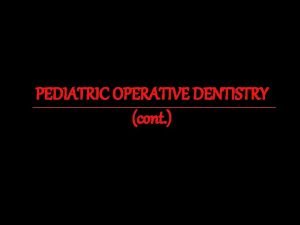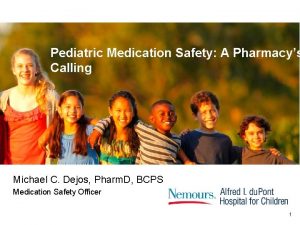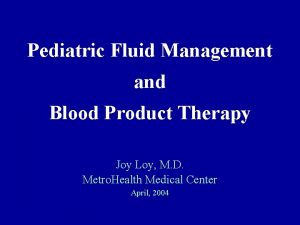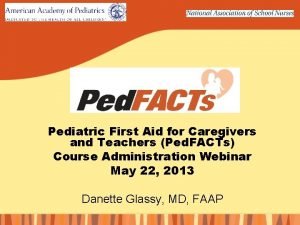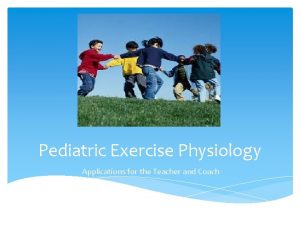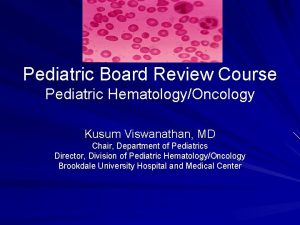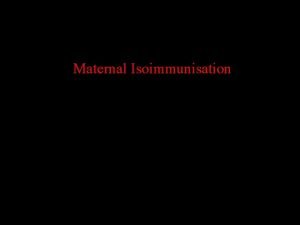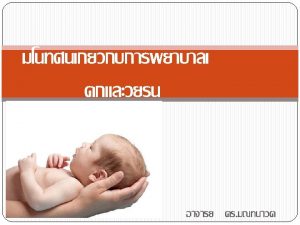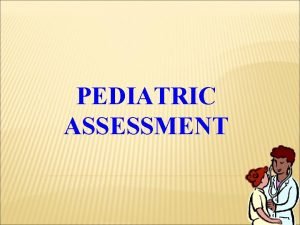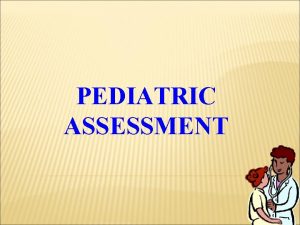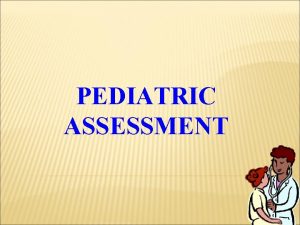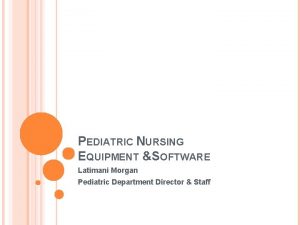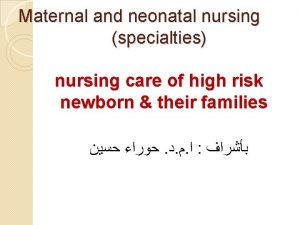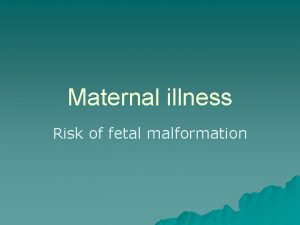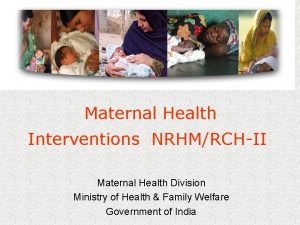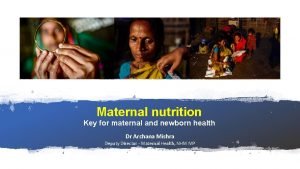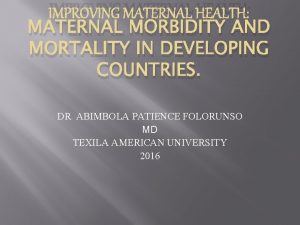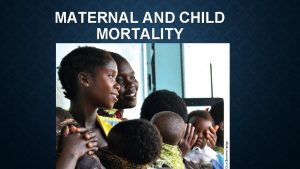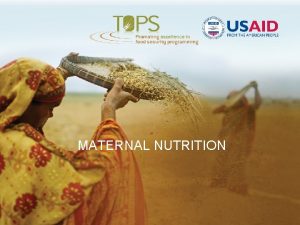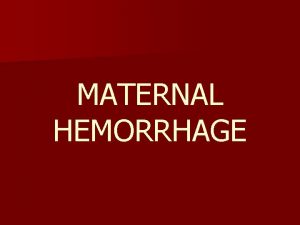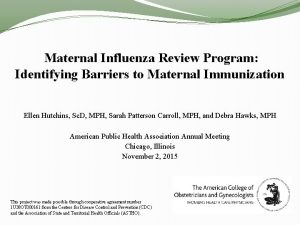SECTION III MATERNAL PEDIATRIC NURSING UNIT 18 NURSING





































































- Slides: 69

SECTION III MATERNAL & PEDIATRIC NURSING UNIT 18 NURSING CARE OF THE CLIENT: CHILDREARING CHAPTER 56 INFANTS WITH SPECIAL NEEDS: BIRTH TO 12 MONTHS L. Lehmkuhl, RN 2008 Copyright 2005 Thomson Delmar Learning. Thomson and Delmar Learning are trademarks used herein under license.

OTITIS MEDIA n n Inflammation of the middle ear. Eustachian tubes in infants are shorter, wider and more horizontal than in adults. Drainage from middle ear to nasopharnyx is often impaired. Secretions and air become trapped as bacteria moves up from pharnyx to the middle ear n n n Irritability, pulling at the infected ear, diarrhea, vomiting, fever, hearing loss. Treatment includes medications or myringotomy for recurrent infections. Prevention: proper positioning when feeding (upright), smoke-free environment (to prevent respiratory congestion). Copyright 2005 Thomson Delmar Learning. Thomson and Delmar Learning are trademarks used herein under license.

Infant Adult Copyright 2005 Thomson Delmar Learning. Thomson and Delmar Learning are trademarks used herein under license.

Middle Ear Infection (Otitis Media) n Otitis media is an inflammation and/or infection of the middle ear. Acute otitis media (acute ear infection) occurs when there is bacterial or viral infection of the fluid of the middle ear, which causes production of fluid or pus. Chronic otitis media occurs when the eustachian tube becomes blocked repeatedly due to allergies, multiple infections, ear trauma, or swelling of the adenoids. Copyright 2005 Thomson Delmar Learning. Thomson and Delmar Learning are trademarks used herein under license.

Copyright 2005 Thomson Delmar Learning. Thomson and Delmar Learning are trademarks used herein under license.

Eustachian tube Copyright 2005 Thomson Delmar Learning. Thomson and Delmar Learning are trademarks used herein under license.

LARYNGOTRACHEOBRONCHITIS Viral illness–swelling of the upper airway. n Symptoms include stridor, “barking” cough, hoarseness. n Treat to maintain a patent airway and improve respiratory effort. n Cool mist and medications. n Copyright 2005 Thomson Delmar Learning. Thomson and Delmar Learning are trademarks used herein under license.

Edema in airways Copyright 2005 Thomson Delmar Learning. Thomson and Delmar Learning are trademarks used herein under license.

• Profuse nasal drainage Copyright 2005 Thomson Delmar Learning. Thomson and Delmar Learning are trademarks used herein under license.

PNEUMONIA Often preceded by an upper respiratory infection. n Onset is abrupt, fever, flaring nostrils, circumoral cyanosis, chest retractions, increased pulse and respirations, cough. n Oxygen, cool mist hydration, respiratory therapy, and medications. n Copyright 2005 Thomson Delmar Learning. Thomson and Delmar Learning are trademarks used herein under license.

Copyright 2005 Thomson Delmar Learning. Thomson and Delmar Learning are trademarks used herein under license.

RESPIRATORY DISTRESS SYNDROME n n n Most often found in pre-term infants. Lungs are deficient in surfactant (a slippery, protective substance, which helps the lungs inflate with air and keeps the air sacs from collapsing). When lungs collapse after each breath O 2 supply reduced n n n Symptoms include tachypnea, retractions, grunting, crackles, pallor, cyanosis, hypothermia, edema, flaccid muscle tone, GI shutdown (no voiding), jaundice, acidosis. First 96 hours are critical to recovery. Treatment: surfactant through endotracheal tube, supportive care (e. g. CPAP). Copyright 2005 Thomson Delmar Learning. Thomson and Delmar Learning are trademarks used herein under license.

CYSTIC FIBROSIS n n Affects lungs, pancreas, liver, and reproductive organs. Autosomalrecessive trait (both parents are carriers) n n Meconium ileus (impacted feces in NB causing Bowel obstruction), intussusception, problems gaining and maintaining weight, pulmonary problems, salty taste on skin. Treat to manage pulmonary complications, postural drainage, high calorie diet (CF asorb only 50% of ingested foods). Copyright 2005 Thomson Delmar Learning. Thomson and Delmar Learning are trademarks used herein under license.

Cystic Fibrosis Copyright 2005 Thomson Delmar Learning. Thomson and Delmar Learning are trademarks used herein under license.

Cystic Fibrosis/Clubbed Fingers n Clubbed fingers is a symptom of disease, often of the heart or lungs which cause chronically low blood levels of oxygen. Diseases which cause malabsorption, such as cystic fibrosis or celiac disease can also cause clubbing. Copyright 2005 Thomson Delmar Learning. Thomson and Delmar Learning are trademarks used herein under license.

Clubbing Copyright 2005 Thomson Delmar Learning. Thomson and Delmar Learning are trademarks used herein under license.

Postural Drainage n There are 6 to 12 positions a person with pulmonary disease may take to drain mucus from a certain part of the lungs. Another person may tap in certain areas to help loosen the mucus and allow it to be coughed out. Other ways to relieve the lung congestion of cystic fibrosis include percussion vests and inhaled aerosols. Copyright 2005 Thomson Delmar Learning. Thomson and Delmar Learning are trademarks used herein under license.

* (often the earliest manifestation)* Copyright 2005 Thomson Delmar Learning. Thomson and Delmar Learning are trademarks used herein under license.

SUDDEN INFANT DEATH SYNDROME (SIDS) “Crib death. ” n Sudden unexpected death of apparently healthy infant. n No single cause has been identified. n Provide empathic support to the family. n Inform family that autopsy must be done. n Copyright 2005 Thomson Delmar Learning. Thomson and Delmar Learning are trademarks used herein under license.

CONGENITAL CARDIOVASCULAR DISEASE n n n n Increased pulmonary blood flow. Decreased pulmonary blood flow. Obstructed blood flow out of heart. Mixed blood flow. Symptoms vary with type of disease. Infants with sever defects often exhibit S/S CHF (fatigue, orthopnea, failure to thrive, pale, mottled or cyanotic skin, tachy, ) Treatment includes medications (dig to increase heart contractibility), surgery. Copyright 2005 Thomson Delmar Learning. Thomson and Delmar Learning are trademarks used herein under license.

* Copyright 2005 Thomson Delmar Learning. Thomson and Delmar Learning are trademarks used herein under license.

Copyright 2005 Thomson Delmar Learning. Thomson and Delmar Learning are trademarks used herein under license.

Copyright 2005 Thomson Delmar Learning. Thomson and Delmar Learning are trademarks used herein under license.

Copyright 2005 Thomson Delmar Learning. Thomson and Delmar Learning are trademarks used herein under license.

HYPERBILIRUBINEMIA Also known as jaundice, yellow discoloration of the skin, sclera, mucous membranes, and body fluids. n Treat to reduce the amount of unconjugated bilirubin. n Treatment is usually phototherapy with a bililight. n Copyright 2005 Thomson Delmar Learning. Thomson and Delmar Learning are trademarks used herein under license.

IRON-DEFICIENCY ANEMIA Full-term infants have iron stores that last for 5 to 6 months. n Surfaces between 9 and 24 months. n Symptoms: pallor, tachycardia, lethargy, irritability, and below-normal hemoglobin, hematocrit, and iron levels. n Treatment is iron replacement (foods, formula, supplements, IM Fe). n Copyright 2005 Thomson Delmar Learning. Thomson and Delmar Learning are trademarks used herein under license.

Copyright 2005 Thomson Delmar Learning. Thomson and Delmar Learning are trademarks used herein under license.

SICKLE-CELL ANEMIA n n Genetic disorder characterized by the production of abnormal hemoglobin. Symptoms not until 6 months of age: abdominal pain, fever, growth retardation, anemia. n n n Prevent crises with hydration. During: bed rest, oxygen, analgesics, fluids. Immunizations for children with this disease include: influenza, pneumococcal, meninggococcal, and hep B. Prophalatic po pcn til 5 -6 y/o Copyright 2005 Thomson Delmar Learning. Thomson and Delmar Learning are trademarks used herein under license.

Copyright 2005 Thomson Delmar Learning. Thomson and Delmar Learning are trademarks used herein under license.

THRUSH Oral fungal infection often acquired after atb treatment of another illness. n Symptoms include painless, white patches that look like curdled milk on the oral mucosa. n Topical nystatin is the most commonly used treatment. n Copyright 2005 Thomson Delmar Learning. Thomson and Delmar Learning are trademarks used herein under license.

ACUTE GASTROENTERITIS Inflammation of the stomach and intestines with diarrhea and vomiting. n The infant may become dehydrated and gravely ill. n Adequate fluids to replace fluid loss (rehydration) is the goal of treatment. n Copyright 2005 Thomson Delmar Learning. Thomson and Delmar Learning are trademarks used herein under license.

COLIC Sudden, periodic attack of abdominal pain, cramping; usually ends by 3 months. n Infant cries for several hours and draws the legs up to the abdomen. n Usually occurs at the same time of day. n Treatment includes medications and exploration of ways to comfort the infant. n Copyright 2005 Thomson Delmar Learning. Thomson and Delmar Learning are trademarks used herein under license.

FAILURE TO THRIVE Infant failing to gain weight and showing signs of delayed development. n Sustained growth failure, developmental delays, poor feeding, sleeping patterns. n Treatment: provide nutrition, promote growth and development, and assist parents to develop skills. n Copyright 2005 Thomson Delmar Learning. Thomson and Delmar Learning are trademarks used herein under license.

CLEFT LIP/PALATE n n May occur separately or together. Infants with cleft palate are at risk for aspiration, feeding difficulties, and respiratory infections. n n Treat to close defects Surgical lip closure @ 6 -12 weeks, followed by palate closure 1218 months. Maintain nutrition, prevent complications, and foster normal growth and development. * n Copyright 2005 Thomson Delmar Learning. Thomson and Delmar Learning are trademarks used herein under license.

Copyright 2005 Thomson Delmar Learning. Thomson and Delmar Learning are trademarks used herein under license.

ESOPHAGEAL ATRESIA WITH TRACHEOESOPHAGEAL FISTULA n n Failure of the esophagus to develop as a continuous passage and/or an unnatural connection between esophagus and the trachea. S/S excessive salivation, drooling, coughing, choking during fdg’s, cyanosis, hx of polyhydraminos (excessive production of amniotic fkluid) durting prenatal period n Prognosis is usually good with surgery Copyright 2005 Thomson Delmar Learning. Thomson and Delmar Learning are trademarks used herein under license.

PYLORIC STENOSIS n n Occurs when circular muscle surrounding the pylorus hypertrophies and blocks gastric emptying. The main symptom is projectile vomiting (ejection up to three feet). Other S/S: hunger, visible peristalic waves, Hyperbowelsounds, irritable, olive shape mass on RUQ Complete recovery with surgery treatment. Copyright 2005 Thomson Delmar Learning. Thomson and Delmar Learning are trademarks used herein under license.

HIRSCHSPRUNG’S MEGACOLON n n n Congenital anomaly manifested as partial or complete mechanical obstruction resulting from inadequate colon motility. Failure to have a stool in the first 24 hours may be indicative of this defect. Surgical intervention is usually necessary. * Copyright 2005 Thomson Delmar Learning. Thomson and Delmar Learning are trademarks used herein under license.

GASTROESOPHAGEAL REFLUX Return of abdominal contents into the esophagus. n Symptoms include hunger, irritability, FTT, vomiting, and frequent upper respiratory infections. n Often resolves with dietary modifications, medication and positioning. n Copyright 2005 Thomson Delmar Learning. Thomson and Delmar Learning are trademarks used herein under license.

INTUSSUSCEPTION Telescoping of one portion of the bowel into a distal portion (part of the intestine being pulled inward into itself) n This can block the passage of food through the intestine. If the blood supply is cut off, the segment of intestine pulled inside can die. n The infant will suddenly become pale, cry out sharply, and draw up the legs in a severe colicky spasm of pain, vomiting and “currentjelly” stool occur. n Barium enema is the main treatment. Copyright 2005 Thomson Delmar Learning. Thomson and Delmar Learning are trademarks used herein under license. n

CONGENITAL TALIPES EQUINOVARUS (CLUB FOOT) n n n Foot has clublike appearance with entire foot inverted, apparent at birth. Treatment includes manipulation and casting of the foot and surgery. Even with aggressive therapy/surgery the club foot may recur. Copyright 2005 Thomson Delmar Learning. Thomson and Delmar Learning are trademarks used herein under license.

DEVELOPMENTAL DYSPLASIA OF THE HIP Dysplasia–refers to a variety of conditions wherein the femoral head and the acetabulum are improperly aligned. n Limited abduction, asymmetry of the gluteal and thigh fat folds, and telescoping of the thigh. n Treatment: casting, bracing and surgery. n Copyright 2005 Thomson Delmar Learning. Thomson and Delmar Learning are trademarks used herein under license.

Copyright 2005 Thomson Delmar Learning. Thomson and Delmar Learning are trademarks used herein under license.

POSITIONAL PLAGIOCEPHALY n n Flattened head syndrome. Occurs when the infant is put to sleep in the same position repeatedly or by neck muscle problems. n n n Not self-correcting. Light-weight plastic helmet to redirect symmetrical growth of infant’s head. Prevention is key…teach parents to alternate sleeping positions. Copyright 2005 Thomson Delmar Learning. Thomson and Delmar Learning are trademarks used herein under license.

MILIA RUBRA Prickly heat. n Rash appears as pinhead-sized erythematous papules. n Often found in folds of skin from being overdressed in Summer heat. n Infants may be irritable because of itching. n Treatment is primarily preventative. n Copyright 2005 Thomson Delmar Learning. Thomson and Delmar Learning are trademarks used herein under license.

DIAPER DERMATITIS Diaper rash. n Erythema, edema, vesicles, papules, and scaling on the perineum, genitals, buttocks, and skin folds. n Treatment: change diapers regularly and keep the infant’s skin clean and dry. n Copyright 2005 Thomson Delmar Learning. Thomson and Delmar Learning are trademarks used herein under license.

SEBORRHEIC DERMATITIS n n Cradle cap. Characterized by yellowish, scaly, or crusted patches on the scalp. Caused by overactive sebaceous gland activity. Crusting can usually be prevented by washing infant’s head with a washcloth and using a finetoothed comb. Mineral oil will help loosen crusty sebum prior to washing. Copyright 2005 Thomson Delmar Learning. Thomson and Delmar Learning are trademarks used herein under license.

ATOPIC DERMATITIS n n n Eczema–chronic superficial inflammatory skin disorder characterized by intense pruritis. Treat to relieve pruritis, hydrate skin, reduce inflammation, and prevent secondary infections. Baths, compresses give temporary relief. n Control allergens: n n n Smoking outside Family pets kept outside * Removing dust Copyright 2005 Thomson Delmar Learning. Thomson and Delmar Learning are trademarks used herein under license.

Dermatitis, Atopic in an Infant n Atopic dermatitis is quite often seen on the cheeks of infants. It consists of red (erythematous), scaling plaques that are diffusely scattered over the infant's body and face. Copyright 2005 Thomson Delmar Learning. Thomson and Delmar Learning are trademarks used herein under license.

SPINA BIFIDA n n Neural tube defect wherein incomplete closure of vertebrae and neural tube results in an opening through which meninges and spinal cord may protrude. Caused by maternal folic acid deficiency during pregnancy n Surgery is required to close the defect. Copyright 2005 Thomson Delmar Learning. Thomson and Delmar Learning are trademarks used herein under license.

HYDROCEPHALUS Results when the balance between the rate of cerebrospinal fluid formation and absorption is disturbed. n Abnormally large head at birth, bulging anterior fontanels, and eyes appear to be pushed downward (sunset eyes ). n Surgical insertion of a shunt is required to drain CSF into body cavity. n * Copyright 2005 Thomson Delmar Learning. Thomson and Delmar Learning are trademarks used herein under license.

FEBRILE CONVULSIONS (seizures) n n n Involuntary muscle contraction and relaxation. Usually occur early in the course of a high fever and carry little risk of neurological damage. Last less than 3 minutes n Usually self resolved and no treatment is necessary If continues treatment includes: anticonvulsants and antipyretics * n Copyright 2005 Thomson Delmar Learning. Thomson and Delmar Learning are trademarks used herein under license.

MENINGITIS The organs of the central nervous system (brain and spinal cord) are covered by n Monitor neurological 3 connective tissue layers status q 4 hours. collectively called the n Treatment includes meninges. spinal tap, isolation, n The three main types are bacterial, tubercular, and medications. viral. n Symptoms sudden or gradual: high-pitched cry, fever, seizures, irritability, vomiting, bulging fontanel, Copyright 2005 Thomson Delmar Learning. Thomson and Delmar Learning are trademarks used herein under license. poor feeding n

CEREBRAL PALSY n n Cerebral palsy is caused by injuries to the cerebrum (the largest part of the brain), which occur as the baby grows in the womb or near the time of birth. Results from damage to the motor centers of the brain. n n Symptoms vary in severity but include motor disorders seizures, impaired vision, difficulty swallowing and speaking. Multidisciplinary team treatment to assist child in developing maximum potential. To improve ambulation surgical intervention such a lengthening the Achilles’ tendon and releasing hamstrings. Copyright 2005 Thomson Delmar Learning. Thomson and Delmar Learning are trademarks used herein under license.

HYPOSPADIAS n Urethral opening is on the ventral surface of the penis often associated with undesended testicles and inguinal hernia n Surgically corrected during the first year of life. Copyright 2005 Thomson Delmar Learning. Thomson and Delmar Learning are trademarks used herein under license.

HYDROCELE n n n Palpable, round, nontender mass in the scrotum. The mass is a collection of fluid. Most close by 1 year of age without intervention. Surgery may be required. Copyright 2005 Thomson Delmar Learning. Thomson and Delmar Learning are trademarks used herein under license.

CRYPTORCHIDISM Failure of the testicles to descend into scrotal sac. n Most descend spontaneously by 1 year of age. n Surgery may be required. n Copyright 2005 Thomson Delmar Learning. Thomson and Delmar Learning are trademarks used herein under license.

VESICOURETERAL REFLUX Backflow of urine from bladder into ureters and possibly the kidneys. n The primary symptom is recurrent UTIs. n Treatment involves preventing UTIs and may require surgery. n Copyright 2005 Thomson Delmar Learning. Thomson and Delmar Learning are trademarks used herein under license.

WILMS’ TUMOR n n Nephroblastoma is one of the most common early childhood cancers found in kidney region. Symptoms may include an abdominal mass to the side of midline, abdominal pain, malaise, anemia, and fever. n n n When palpate abdominal if mass if felt stop immediately to prevent dislodging tumor cells. Surgery is the treatment of choice. Chemotherapy, radiation also used. Copyright 2005 Thomson Delmar Learning. Thomson and Delmar Learning are trademarks used herein under license.

Wilms Tumor Copyright 2005 Thomson Delmar Learning. Thomson and Delmar Learning are trademarks used herein under license.

DOWN SYNDROME Chromosomal anomaly resulting in moderate to severe mental retardation. n Almond-shaped eyes, depressed nasal bridge; protruding tongue; low-set ears; short, broad neck; transverse palmar crease, broad, short hands with stubby fingers; and protruding abdomen. n Copyright 2005 Thomson Delmar Learning. Thomson and Delmar Learning are trademarks used herein under license.

Copyright 2005 Thomson Delmar Learning. Thomson and Delmar Learning are trademarks used herein under license.

VISUAL IMPAIRMENT Refractory disorders. n Strabismus. n Corrective lenses, patching, and surgery may be required. n Copyright 2005 Thomson Delmar Learning. Thomson and Delmar Learning are trademarks used herein under license.

Crossed Eyes n eyes that are not looking in the same direction, which is referred to as crossed eyes (strabismus). Other more specific medical terms refer to eyes turned either outward or inward, or that are abnormally rotated. Any appearance of crossed eyes in young children should be immediately evaluated, as should recent onset of crossed eyes in an adult. Copyright 2005 Thomson Delmar Learning. Thomson and Delmar Learning are trademarks used herein under license.

HEARING IMPAIRMENT n n n Conductive loss: Transmission of sound is interrupted to middle ear Sensorineural loss: r/t auditory nerves Mixed hearing loss: combo of conductive and sensorineural Central hearing loss: reoccurring otitis media when brain stem and cerebral cortex impairs sound conduction Treatment depends on the cause and type of loss. Copyright 2005 Thomson Delmar Learning. Thomson and Delmar Learning are trademarks used herein under license.

Hearing Test n Newborns are routinely screened for their hearing shortly after birth to prevent delays in normal language skills. In one test, a small earpiece is placed in the outer part of the baby's ear. The earpiece emits clicking sounds into the baby's ear and the microphone in the earpiece detects nearby sounds. The sounds should echo in the ear canal. If there is no echo, it is a sign of hearing loss. Copyright 2005 Thomson Delmar Learning. Thomson and Delmar Learning are trademarks used herein under license.

ABUSE AND NEGLECT n Abuse–any intentional act of physical neglect or physical, emotional, or sexual abuse committed by a person responsible for the care of a child. n n n If parent and child explanations do not match… Document verbatim (“in quotient marks”) both parent and child subjective data All cases of suspected child abuse must be reported. Copyright 2005 Thomson Delmar Learning. Thomson and Delmar Learning are trademarks used herein under license.

Copyright 2005 Thomson Delmar Learning. Thomson and Delmar Learning are trademarks used herein under license.

ENVIRONMENTAL SAFETY Poisoning. n Trauma. n Suffocation. n Drowning. n Prevention is of utmost importance. n Copyright 2005 Thomson Delmar Learning. Thomson and Delmar Learning are trademarks used herein under license.
 Non nuclear inheritance
Non nuclear inheritance Extranuclear inheritance
Extranuclear inheritance Hamlet act iii scene ii
Hamlet act iii scene ii Trends in pediatric nursing
Trends in pediatric nursing Modern concept of child health care
Modern concept of child health care Modern concept of pediatric nursing ppt
Modern concept of pediatric nursing ppt Pediatric nurse definition
Pediatric nurse definition Principles of atraumatic care
Principles of atraumatic care What is atraumatic care
What is atraumatic care Family system theory
Family system theory Pediatric nursing definition
Pediatric nursing definition What are the 5 heart sounds
What are the 5 heart sounds Lochia assessment
Lochia assessment Plasenta bilobata
Plasenta bilobata X linked dominant pedigree
X linked dominant pedigree Cmqcc maternal data center
Cmqcc maternal data center Maternal causes of polyhydramnios
Maternal causes of polyhydramnios National health program related to child health
National health program related to child health Prophase
Prophase History of maternal and child health
History of maternal and child health Factors influencing maternal health
Factors influencing maternal health Sanford maternal fetal medicine
Sanford maternal fetal medicine Color of amniotic fluid
Color of amniotic fluid What does infected lochia look like
What does infected lochia look like Ramona t. mercer
Ramona t. mercer Maternal death reporting format
Maternal death reporting format Maternal and child health services
Maternal and child health services Choose the correct option. p3m:n4j:r3p:
Choose the correct option. p3m:n4j:r3p: La muda de la flor eduardo kingman
La muda de la flor eduardo kingman An inspector calls act 1 revision
An inspector calls act 1 revision Z score for malnutrition
Z score for malnutrition Chapter 15 maternal and fetal nutrition
Chapter 15 maternal and fetal nutrition Calendario maternal
Calendario maternal Maternal pelvis and fetal skull
Maternal pelvis and fetal skull Diameters of fetal skull
Diameters of fetal skull Onset of labour
Onset of labour Fetal presentation
Fetal presentation Sub mento bregmatic diameter
Sub mento bregmatic diameter Maternal behavior
Maternal behavior Types of recombination
Types of recombination Sepsis 6 bundle
Sepsis 6 bundle Maternal deprivation
Maternal deprivation Desde o seio maternal sois meu amparo
Desde o seio maternal sois meu amparo What is maternal health
What is maternal health Maternal transfer of antibodies
Maternal transfer of antibodies Maternal effect
Maternal effect Isolated maternal hypothyroxinemia
Isolated maternal hypothyroxinemia Civil.status
Civil.status Shell coiling in snail
Shell coiling in snail Jama 2017
Jama 2017 Global causes of maternal death: a who systematic analysis
Global causes of maternal death: a who systematic analysis Brow presentation
Brow presentation Unit 10, unit 10 review tests, unit 10 general test
Unit 10, unit 10 review tests, unit 10 general test Unc hematology and oncology
Unc hematology and oncology Miami pediatric nephrology seminar
Miami pediatric nephrology seminar Define pediatric dentistry
Define pediatric dentistry Headache red flags
Headache red flags Pediatric seizures
Pediatric seizures Vital signs normal range
Vital signs normal range Plasmlyte
Plasmlyte Jvas vision screening
Jvas vision screening Pediatric urologist in atlanta ga
Pediatric urologist in atlanta ga Spo2 normal range by age chart
Spo2 normal range by age chart Pediatric class 2 prep
Pediatric class 2 prep Common pediatric medications
Common pediatric medications Im injection sites and volumes pediatrics
Im injection sites and volumes pediatrics 4 2 1 fluid rule
4 2 1 fluid rule Pediatric first aid for caregivers and teachers
Pediatric first aid for caregivers and teachers Pediatric exercise physiology
Pediatric exercise physiology Pediatric hematology oncology board review
Pediatric hematology oncology board review
